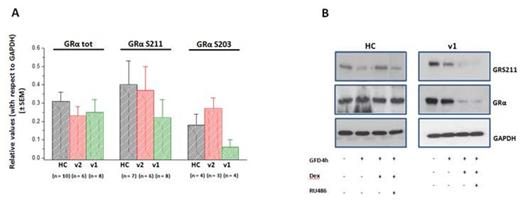Abstract
Cushing's disease (CD) is a rare endocrine disorder (1.2-2.4/million/year) characterized by chronic excess endogenous glucocorticoids (GC) due to an adrenocorticotropic hormone-secreting pituitary adenoma. Untreated CD results in increased mortality and multiple morbidities (obesity, diabetes, hypertension, cardiovascular disease) and, in one case report, erythrocytosis (Gursoy et al, J End Invest. 2006;29:742). The effects of chronic GC exposure on erythropoiesis in a CD cohort have not yet been studied.
We prospectively quantified hematocrit (Hct), hemoglobin (Hb) and platelets (ptl) values in CD patients before (v1) and after surgical remission (v2, mean time since surgery=14.5 months) and in matched healthy controls (HC). Frequency, antigenic profiling and erythroid (Ery) expansion potential of circulating hematopoietic progenitor cells (HPC) in the three cohorts were also evaluated. The subjects analyzed included 28 v1 [6 males, 22 females, mean age=41 years; body mass index (BMI)=33.3 kg/m2 ] and 13 HC [2 males, 11 females, mean age=41 years; BMI=30.7 kg/m2 (range 26.7-34.7, p=0.073). Eleven patients were analyzed over time in both v1 and v2.
Mean cortisol in v1 (22.2±6.3 ug/dL) was higher than in HC (8.5±3.8 ug/dL, p=3.4E-07) and decreased in v2 (17.6±5.1% vs. 8.7±3.9%, N= 11, p=0.0006). Hct was higher in v1 than in HC (39.8±4.7%, vs. 38.8±2.7%, p = 0.045). In the 11 patients analyzed over time, hct decreased in v2 vs. v1 (39.2±4.7% vs. 42.3±4.4%, p=0.011). Hb in v1 was not different than in HC (13.10±1.6 vs. 13.12±3.8 g/dL, p =0.225) but decreased in patients studied both in v1 and V2 (14.1±1.5 g/dL vs. 13.2±1.8 g/dL, p=0.009). Similarly, plts were not different in v1 and HC (272.3±81.4 vs. 240.8±76.0 K/uL, p=0.274) but decreased in v2 (307.7±112.1 vs. 270.6±74.5 K/uL, p=0.021). In v1, Hct did not correlate with serum (R = 0.34, p = 0.33) or 24h urine (R = 0.072, p = 0.73) cortisol concentrations.
There was no difference in frequency of HPC among v1, v2 and HC [2.6±3.0, 0.34±0.28 and 1.26±0.67% of CD34+ cells and 30.2±27.2, 23.7±13.2 and 16.5±11.5 CFC/105 mononuclear cells (MNC) in v1, v2 and HC]. CD34pos cells from all groups expressed similar levels of cKIT, IL-3Rβ and prominin1, but a greater proportion of those from v1 and v2 expressed thrombospondin and thrombopoietin (Mpl) receptors than those from HC (2 vs 0.4%), suggesting that CD HPC are biased toward erythro-megakaryocytopoiesis. Consistently, in cultures without the synthetic GC dexamethasone (Dex), MNC from v1 (12±6 %) and v2 (19%) generated in 10 days a greater proportion of Erys than MNC from HC (2±1% ). However, in cultures with Dex, MNC from v1 (48±25), but not those from v2 (70±23), generated less Erys than MNC from HC (83±26 , p=0.03), suggesting that Erys from v1 HPC respond poorly to Dex. This was tested by comparing the ability of Dex to induce biochemical (GRα phosphorylation at S211 and cell-surface expression of CXCR4/calreticulin) and biological (proliferation in synergy with growth factors, GFs) responses in Erys from CD and HC. Erys from v1, v2 and HC expressed equivalent levels of GRα but those from v1 Erys contained lower levels of pGRαS211/S203 than those from v2 or HC (Fig 1A). In contrast with HC Erys, Dex decreased GRα and did not induce pGRαS211 in v1 Erys (Fig 1B). Moreover, Dex increased cell-surface expression of CXCR4 (MFI from 580 to 700) and calreticulin (MFI from 300 to 700) and proliferation (by 30%) in HC Erys but not in those from v1 s (CXCR4 MFI from 278 to 154, calreticulin MFI from 136 to 152; proliferation increases by 6%).
These results indicate that chronic GC excess increases Hct values but may also activate a post-transcriptional mechanism that reduces GRα expression inducing desensitization of erythroid cells to GC.
A) Levels of total, pS211 and pS203 GRα in Erys from HC, v1 and v2. B) levels of GRα and GRα phosphorylated at pS203 in Erys from HC and v1 exposed from 15' to Dex alone or in combination with the GR inhibitor RU486.
A) Levels of total, pS211 and pS203 GRα in Erys from HC, v1 and v2. B) levels of GRα and GRα phosphorylated at pS203 in Erys from HC and v1 exposed from 15' to Dex alone or in combination with the GR inhibitor RU486.
No relevant conflicts of interest to declare.
Author notes
Asterisk with author names denotes non-ASH members.


This feature is available to Subscribers Only
Sign In or Create an Account Close Modal